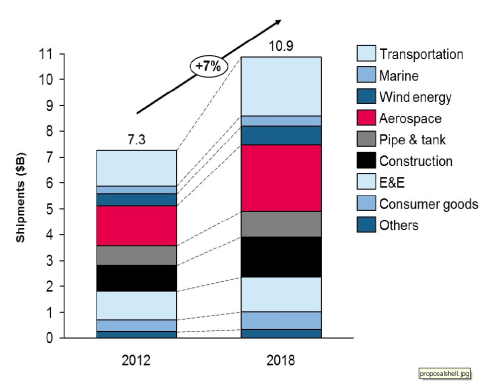

At the American Composites Manufacturers Association (ACMA)'s COMPOSITES 2013 trade show in Orlando, Florida (19-31 January), Chuck Kazmierski, Program Manager at Lucintel, reported that the composite materials industry in North America reached US$7.3 billion in 2012, up 9.5% from 2011.
In his conference presentation Growth Opportunities in the North American Composites Industry, Kazmierski also forecast that the industry will grow at a compound annual growth rate (CAGR) of around 7% to reach $10.9 billion in 2018.
The road to recovery
During the past five years 2007-2012 the North American composites market declined 2.7% in volume terms, Lucintel reports. In the recession of 2008 and 2009 the market was down by 25-30%, it adds, with the marine market and consumer goods sectors being hit particularly hard, down 30% over those two years, while the construction sector dropped by 20%.
However, it was not all bad news. The aerospace and wind energy composites markets increased during 2007-2012, both demonstrating CAGRs of over 10%. Increasing demand for military and commercial aircraft, and government support for renewable energy, helped these sectors, Lucintel reports.
| The market value of end use products made with composites was $20.9 billion in 2012. |
| Lucintel |
In 2012 the composites market was driven by double-digit growth in the wind energy and automotive industries, Lucintel reports, as well as robust growth in the housing market. In fact, composites industry growth in 2012 outpaced US GDP (which grew by an estimated 2.1% in 2012 from 2011). Consumer confidence also increased in 2012 driven by increased job opportunities, stabilising fuel prices, and an improving housing market.
Prospects
In his presentation, Kazmierski stated that the North American composites market will be completely recovered from the 2008/2009 economic recession by 2014, with strong recovery in the transportation and construction markets. Double-digit growth in the wind energy and aerospace markets is also expected going forward.
Corporate Average Fuel Economy (CAFE)First enacted by the US Congress in 1975, the purpose of CAFE is to reduce energy consumption by increasing the fuel economy of cars and light trucks. CAFE requires vehicle manufacturers to comply with the gas mileage, or fuel economy, standards set by the US Department of Transportation (DOT) and Environmental Protection Agency (EPA). In August 2012 the Obama Administration finalised standards to increase fuel economy to the equivalent of 54.5 mpg for cars and light-duty trucks by model year 2025. This builds on the previous standards for model years 2011-2016 which raised average fuel efficiency by 2016 to the equivalent of 35.5 mpg. Further information: National Highway Traffic Safety Administration (NHTSA). Renewable Electricity Production Tax Credit (PTC)The federal renewable electricity PTC is a per-kilowatt-hour (kWh) tax credit for electricity generated by qualified energy resources and sold by the taxpayer to an unrelated person during the taxable year. It generally applies to first 10 years of operation of a renewable energy facility. Originally enacted in 1992, the PTC has been renewed and expanded numerous times. In January 2013 the legislation was revised, removing 'placed in service' deadlines and replacing them with deadlines that use the beginning of construction as a basis for determining facility eligibility, and extending the deadline for wind energy facilities by one year, from 31 December 2012 to 31 December 2013. For wind energy the credit amount is 2.3¢/kWh for facilities under construction by 31 December 2013. Further information: DSIRE (Database of State Incentives for Renewables & Efficiency). |
New CAFE standards of 54.5 mpg by 2025 will increase demand for lightweight materials such as composites in the automotive industry, while PTC and ITC (Business Energy Investment Tax Credit) extensions will aid the wind energy market.
"There are hundreds of opportunities for composites within reach, where concepts have been proven and technological risks have been eliminated; such applications are now ready for significant increase in market penetration" – Lucintel
Lucintel points out that although the US has the highest composites consumption per capita in the world, there are still many application areas, including transportation and construction, where composites penetration is less than 2% and there are significant opportunities for growth. ♦
Also see:





